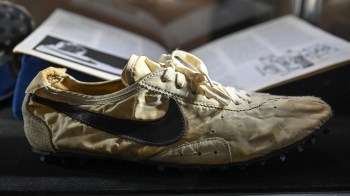Art sales recovering in slow economy
TEXT OF INTERVIEW
Kai Ryssdal: Tomorrow and Wednesday in New York it’s art auction time. It’s the fall contemporary season at Sotheby’s and Christie’s. Paintings by Andy Warhol, Jasper Johns, Willem De Kooning and many others will be up for sale. Just a couple of years ago a lot of those paintings would have been flying off the auction block, hammered down for tens of millions of dollars. To find out how things might shape up this fall, we’ve called art dealer Richard Polsky. Welcome to the program.
RICHARD POLSKY: Thanks. Thanks for having me on.
Ryssdal: Give me the art market vibe right now, would you?
POLSKY: Well, I’m happy to say it’s rapidly improving. We had two very good sales at Sotheby’s and Christie’s. These were the Impressionist and Modern sales. Actually, Sotheby’s was OK, I shouldn’t over exaggerate it. But Sotheby’s ending up exceeding the total that they expected to bring in. And that set the vibe I’d say and the bar pretty high for this week’s sales for the contemporary sales.
Ryssdal: Everybody in this art market knows that there’s this huge recession, right? And unemployment is at 10.2 percent, and the whole deal?
POLSKY: But the people who buy art, they’re not the 10.2 percent. Three or four years it was like everyone into the pool. You had all these people who loved art, but you also had a lot of speculators. People saying, hey, art’s got the hot hand. It’s a tangible asset, I’m going to move some money into it. And they were grossly overpaying. You also had these Russian oligarchs just overbidding on blue chip paintings. The market was really international back then. It’s kinda slimed down now. Anyone buying now long-term player, connesuir, wants to live with the art, not buying to flip.
Ryssdal: Now you have a client with a painting that’s coming up for auction, right?
POLSKY: Right, right. Basically years ago in the art market, the way I’d make my living is you would come to me, you’d have an Andy Warhol painting for sale, let’ say. And I’d say, great, I’m going to handle this sale, I’m going to get you the best deal, and I’m going to, of course, make a profit. Usually I’d be looking to make 10 percent om a deal like that. But with the rise of the auction houses, and their dominance, all of the sudden you come to me with that same Warhol, and it would be disingenuous of me to say give it to me, when clearly the better deal is to test the auction waters. So now what I’ve done is basically said OK, you’re going to auction with that painting. However, let me represent you. Let me go to Sotheby’s and Christie’s and get you the best deal.
Ryssdal: Sort of sounds like you’ve created a middleman job here.
POLSKY: Well, that’s what it is. You know, I hate to say I’m an art advisor or a financial advisor. But it really does come down to pure business at this point. You have to know what you’re holding as an art dealer. You come to me with a painting, I’ve got to make a determination, do I have an ace here, or just the seven. But if I’ve got the ace, you know you drive a hard deal.
Ryssdal: So what kinds of paintings are selling?
POLSKY: I’m going to give you an example of something that will probably do well at this current round of sales. Back in 1967, there were two women who wanted to work for Andy Warhol. They go to his gallery, it’s called Leo Castelli, and they meet his gallery director, a guy named Ivan Karp, and they say, “Hey we want to work for Andy.” And he says, “Just a minute.” He gets Warhol on the phone. I mean you could do that in those days, it was a different world. And he says, “Hey, I’ve got two squirrels here who want to come work for you.” Anyway, they go to work for him. One of them sticks it out, the other one, I think, quit. After working for him for a year, and she was not getting paid, he was working on these self-portraits, and Warhol says to her, “Here, why don’t you pick one out.” OK, these paintings are 22-inches square. And she picks out, I don’t the woman had a sick sense, one of the best ones I’ve ever seen: purple, red and green, killer pop colors, just beautiful. Anyway, flash forward, she’s hung on to that painting until now. Decides to finally bring it out. And it’s coming up at Sotheby’s. Estimate $1 million to a $1.5, unbelievable, instant millionaire.
Ryssdal: Richard Polsky. He’s an art dealer, art advisor I guess, you are, right, Richard? He’s also the author of the recent book “I Sold Andy Warhol Too Soon.” Richard, thanks a lot.
POLSKY: Thank you very much.
There’s a lot happening in the world. Through it all, Marketplace is here for you.
You rely on Marketplace to break down the world’s events and tell you how it affects you in a fact-based, approachable way. We rely on your financial support to keep making that possible.
Your donation today powers the independent journalism that you rely on. For just $5/month, you can help sustain Marketplace so we can keep reporting on the things that matter to you.


















